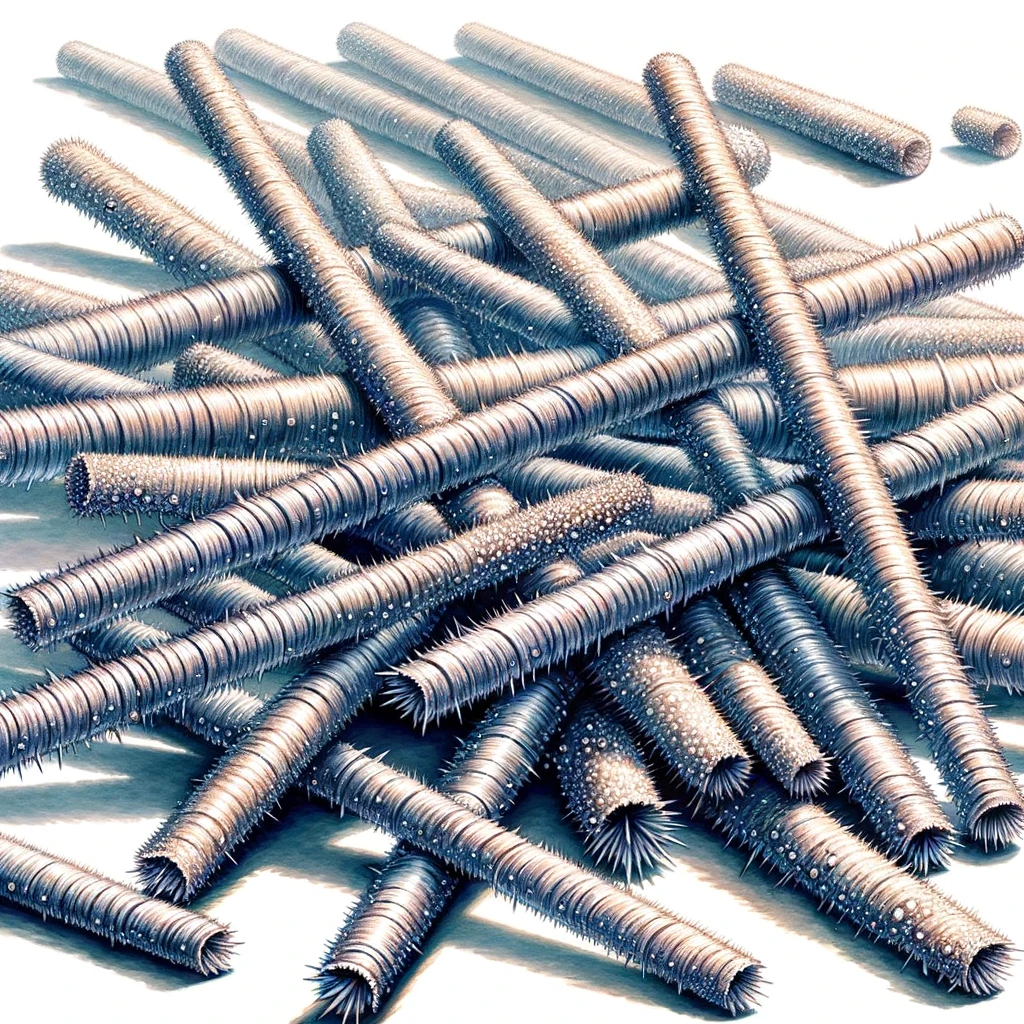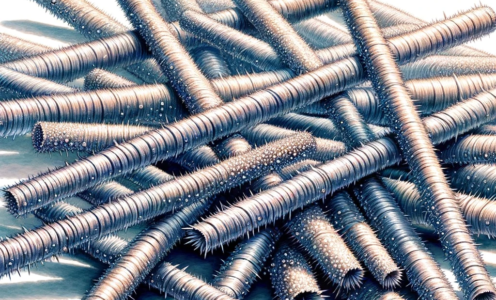Chardes
| CLIMATE/TERRAIN: | Quasi-Elemental Plane of Mineral, Outlands |
| FREQUENCY: | Rare |
| ORGANISATION: | Pack |
| ACTIVITY CYCLE: | Any |
| DIET: | Any mineral |
| INTELLIGENCE: | Average (8-10) |
| TREASURE: | Nil |
| ALIGNMENT: | Neutral |
| NO. APPEARING: | 2-20 |
| ARMOUR CLASS: | 5 |
| MOVEMENT: | Fly 20 (A) |
| HIT DICE: | 6 |
| THAC0: | 13 |
| NO. OF ATTACKS: | 2 |
| DAMAGE/ATTACK: | 2d6 / 3d10 or impale |
| SPECIAL ATTACKS: | Coil, impale |
| SPECIAL DEFENCES: | Immune to metal weapons and acid |
| MAGIC RESISTANCE: | Nil |
| SIZE: | Varies |
| MORALE: | Fearless (19-20) |
| XP VALUE: | 650 |

“Aye, seen them I have. Nasty things they be, too. They cut down me whole lot o’ friends. And I mean that literally. I was lucky though, I was. They only got me arms. Hurt like the nine hells though. Lucky I says, I got myself away from there right quick like. Or I’d be a headless bubber and not an armless one. And a headless bubber is no bubber at all.”
“I ain’t the least bit ashamed to say I still get nightmares about the things. They say they hunt you after they attack. I believe it, if not literally then figuratively. Now if you’ll be excusin’ me I need to see a bubser about a drink.”
And with that he left, the poor retired traveler heading towards the nearest alehouse, long ago having given up on being so paranoid about his attack. But as any planewalker knows, grudges, and lusts never fade. He was dreadfully unprepared when the attack came. He was shredded to pieces a mere ten feet from where I stood…
— Excerpt from Med Mert’s Travel Journal
One of the most fearsome creatures of the Inner Planes, chardes always appear as thin cylindrical metal rods, the surface glittering with microscopic crystalline barbs. They range in size anywhere between 1 inch long, to a full 70 feet long. Despite their length they remain a mere 1/4 inch thin.
COMBAT: In combat chardes are particularly fierce adversaries. When an encounter starts they use their natural senses to detect magic, then they direct their initial attack at a magic user, or a hand holding an enchanted item. They attack in three ways.
First and most common is a dive/slash attack which causes 2d6 damage.
Second and definitely more devastating is their coil attack. They will wrap themselves around an arm, leg, neck, tail, or any other section of the body their length allows them to surround at least twice around. They then begin to spin at lightning quick speeds, causing 3d10 damage, and quickly sawing through all non magic material. Enchanted material at less than +2 requires a saving throw. They can not destroy +3 or better items. This includes armour, weapons, body parts, etc. Please use your own judgment for items such as magical staves, rods, wands, etc. Items save against disintegration; PCs save versus paralyzation. Those items failing their rolls are sawn in half, those PCs that fail lose a limb as per a vorpal sword. Should a charde get a natural 20 on it’s attack roll it automatically cuts through all armour regardless of it’s magical bonus, and severs the limb.
Lastly they can impale a victim on themselves. By launching themselves at their target and getting a successful attack they proceed to bore through armour (again, nonmagical is destroyed automatically, under +2 a saving throw, +3 or above deflects the attack). A successful impalement causes 4d4 damage.
Often when large groups of chardes attack they will impale a victim many times over, coiling around while still embedded in flesh, and saw chunks off. Many times a victim of a charde attack is little less than a pile of powdered bones and pulp.
HABITAT/SOCIETY: Chardes roam the Quasielemental Plane of Minerals in packs of 2-10 creatures. They devour precious gem deposits, and often other inhabitants of their home-plane. They constantly hunt, and are hunted by, the Tsnng.
Aside from that they have little to no society. No one has yet to see how, or when they reproduce, but there is never a shortage of chardes on this plane.
When a lucky cutter escapes a pack of chardes he’d best watch his back. 90% of the time chardes will hunt their wounded prey down. They have an uncanny sense to track the wounded they have drawn blood from. If the target shifts planes of existence there is a 70% chance the chardes will end the pursuit. Otherwise they will actively seek a portal and hunt them down. While they may not know what plane their target fled to, they instinctively recognize it if/when they arrive.
The only end to these stalkings is the death of either the prey, or the hunter.
ECOLOGY: Not much is known about chardes. There a few theories out there I will share with you:
The most widespread belief is that some clueless priest found his way onto the plain and tried to cast a Blade Barrierspell. It’s effects twisting to create the first of many chardes.
Another popular belief is they are small bits broken off of some larger, crystalline porcupine type creature. Neither story can be confirmed, but what about the planes can? Regardless of their origins, be wary of them, or you’ll find yourself in boxes and pieces.
Once dead, chardes continue to spin. A careful blood with a long winded hold spell could conceivably create a magical blade, more fearsome than any sword of sharpness known. The is reputed to be one traveler that sells magic items made from chardes.
Summon Chardes
6th Level Wizard Spell (Conjuration/Summoning)
This spell is similar to the 6th level priest spell blade barrier, save two things. Firstly, rather than a barrier of whirling blades, this spell summons a wall of 2d10, very angry chardes. The pack is confined to the spell’s area of effect, and will utterly destroy any creature, or obstacle in its vicinity. Secondly, the pack remains after the duration of the spell is complete. At this point, the caster loses all control over the pack, and all of the spell boundaries are nullified.
This is a dangerous spell to cast, unless used to block the path behind the caster. Should the chardes still be able to see the caster when the spell’s duration is at its end they’re very likely to attack them.
Source: The Jester Lich


